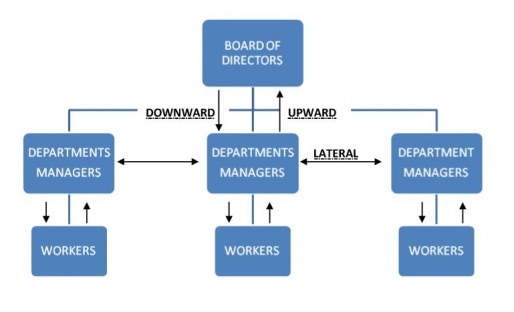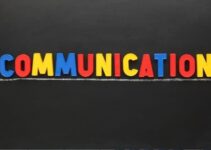Types of Communication in Organization
Communication is a very important part of any organization. It takes place among business entities, within markets, various groups of employees, buyers and sellers, service providers and clients, salesperson and prospective buyers, and within the organization and with the press.
Communication can be Internal, External, Upward, Downward, Formal, Informal, Lateral, Interactive, Mass or Grapevine.
Internal Communication
Internal communication takes place within the organization or group–among people within, among different groups of employees and between employers and employees. It could be oral or written, visual or audio-visual, formal or informal, and upward or downward. Internal communication serves to inform, instruct, educate, develop, motivate, persuade, entertain, direct, control and caution people in the organization.
When a personal letter is written at an official address, besides writing the name of the addressee, the envelope is superscribed ‘Private’ or ‘Confidential’ to convey the nature of communication. Knowledge, skills, goal orientation, sharing of corporate concerns, review and monitoring, performance appraisal, counseling and training are among the issues that internal communication addresses.
External Communication
Unlike internal communication, external communication flows outward. It addresses people outside the organization, like the prospective customers, competitors, public, press, media and the government. External communication can take place in various ways and through different channels.
Letters, notices, brochures, demonstrations, telephone calls, business meetings, press releases, press conferences, audio-visual presentations, publicity films product launch events and advertisements are all examples of external communication. It is important to note that the external agency or person targeted through such communication, quite often forms an image or impression based on such communication and it is, therefore, very necessary that adequate care is taken in making it clear, intelligible and appealing.
There may be some communication, which would move both upward and downward. A typical example of this is performance budgeting, which is a two-way process. It is a top to bottom as well as bottom-to-top exercise
Upward Communication
Large organizations have different hierarchical levels or tiers. Banks, finance companies, insurance businesses, railways, and such other people-oriented organizations have typically a 3-tier or a 4-tier structure. The process of communication to be complete and effective should encompass all these levels and tiers. Upward communication is one which moves upward, i.e., from bottom to top levels in the hierarchy.
Any communication that moves from employees to supervisors, supervisors to managers, managers to executives, regional manager to general manager and so on, maybe categorized as upward communication. Similarly, communication from branches to regional offices, regional offices to zonal offices, zonal offices to head office is referred to as upward communication. Employee suggestions, market reports, performance reports, feedback on new products and requests for facilities or instructions are all examples of upward communication in the organizational context.
Downward Communication
Downward communication moves from top to the bottom, i.e. from the CEO downwards. It travels through senior executives to junior level functionaries, from the controlling office to the branch, from the head of the division to the head of the unit. Corporate goals, business priorities, motivational letters, work-related instructions, newsletters, letters from the CEO/General Manager’s desk are all typical examples of downward communication.
There may be some communication, which would move both upward and downward. A typical example of this is performance budgeting, which is a two-way process. It is a top to bottom as well as bottom-to-top exercise
Formal Communication
Towards ensuring communication on an on-going basis, organizations develop formal systems. Staff meetings, union-management meetings, branch managers’ conferences, periodical sales review meetings and customer meets are examples of forums that facilitate formal communication.
Formal communication generally follows a well-defined hierarchical pattern and periodicity. Memos, circulars, instructions, guidelines, clarifications, agreements and reports are some of the channels that facilitate the flow of formal communication in business organizations.
Informal Communication
This type of communication takes place in an unstructured manner and outside the formal forums. There is an element of spontaneity in this communication. Informal communication works well in smaller, loosely knit organizations. It is used more often in situations where there are no rigid hierarchical tiers.
While the formal structure of communication is a must in large organizations, it is the informality that helps sustain goal orientation in small well-knit units. Informal communication takes place through chats, conversations, informal talks and the like.
Lateral Communication
Lateral communication generally takes place in an organization and is neither upward nor downward. It proceeds in a horizontal manner and takes place among equals and at peer level. It may also be described as peer-level communication.
Any communication that takes place, orally or in writing, from one branch head to the other, from one division head to the other, from one group head to the other, maybe described as lateral communication. An important point worth noting in any such lateral communication is that there is not much difference in terms of the hierarchical levels or positions of the sender and the receiver.
Interactive Communication
Interactive communication is essentially a two-way process. It takes place through meetings, conferences, teleconferencing, multimedia presentations, group discussions, and other such active two-way exchanges. Interactive communication is most appropriate when the message or
subject is to be presented at length, e.g., in practical sessions, case study discussions, and strategy formulation. When many speakers are involved, there may be a need for a moderator who will facilitate the effective flow of communication from different speakers.
Mass Communication
Mass communication is distinctive in view of its scale. Essentially, it addresses a large mass of people. Public speaking, newspapers, magazines and journals, radio, television, dotcoms, etc. are channels of mass communication. Mass communication has developed into a specialized area of study.
Each of these areas or channels calls for distinct skills. By its very nature, mass communication addresses a vast, well spread out and heterogeneous group of people and, as such, special efforts will have to be mode to sustain their interest and achieve the desired response.
At the government level too, there is often a separate ministry or department of mass communication to deal with this functional area. Main branches of study relating to mass communication are public relations, advertising and publicity, journalism and digital media.
Grapevine
Grapevine is a kind of informal communication that prevails in organizations and businesses. The source of such communication may not be clear. It spreads by way of gossip and rumors. It travels through informal networks and quite often travels faster than the formal messages. Sometimes, it gets more powerful and becomes more receptive than formal communication.
The prevalence of this type of communication in an organization has to be recognized and accepted. A skilled communicator can derive benefits from such communication as well. It may not always be possible to control the grapevine, but, nevertheless, an able communicator knows how to influence it. Like any other type of communication, this one has its own merits and demerits.

















